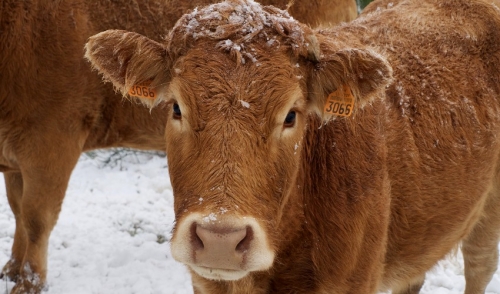{article.name}
Pay close attention to winter nutrition for your cattle

- Share this:
- Share on Facebook
- Pin on Pinterest
- Tweet on Twitter
Taking shortcuts on your cattle nutrition during the winter months could be risk next year’s calf crop, this year’s weaning weights and the long-term viability of your herd. According to information from University of Minnesota Extension beef experts, winter feeding programs vary for each cattle enterprise.1 Feeding programs are dependent on variables such as:
- Forage quality.
- Cost and availability of winter supplements.
- Animal type (mature cows, replacement heifers or back-grounded calves).
- Body condition of your cattle.
- Calving date, if applicable.
The Minnesota beef experts explain that generally, winter feeding can be accomplished with harvested forages such as hay and silage. Grazing crop residues can also be utilized, but may not always be feasible in areas that receive significant amounts of snowfall during early winter months. Cows can graze through up to 9 inches of snow to get high quality forages, but reduced forage intake will occur with as little as ¼ inch of ice covering the snow. Plus, cold temperatures and precipitation can decrease the feed’s nutritional value.
Regardless of whether you feed stored forages or graze crop residues, the cow’s diet must be sufficient to uphold a body condition score (BCS) of 5 at weaning, a 6 at calving, and no less than a 5.5 score at breeding. At this level of condition, a cow is able to maintain its body weight and support production functions such as lactation and fetal growth. Maintaining adequate body condition in pregnant cattle is crucial in the two to three months prior to calving.
Feeding Supplements
Depending on the quality of forage, supplementation may be needed by cows when nutrient demands are not met by the basic diet the cow is offered, say the Minnesota experts. Typically, diets of late gestating beef cows will meet nutrient needs if they contain a minimum of 55 percent total digestible nutrients (TDN ) and 8 percent crude protein (CP). However, lactating cow minimum requirements during the winter increase to 62 percent TDN and 11 percent CP, such as with fall calving cows.
When feeding pregnant first- and second-calf heifers due to calve in the spring, maintaining a diet with TDN at 60 percent and CP at 11 percent from the beginning of winter through early lactation should be sufficient.
It is important to compare nutrient intake of the diet with nutrient requirements of the cow based on animal type and pregnancy status, and to determine what additional nutrient(s) are needed for supplementation.
Evaluate Cow Performance
Throughout the winter, it’s important to evaluate cow performance by observing body weight and condition changes resulting from your feeding program. This will tell you if you are correctly supplementing your cattle through the winter and preparing those spring calving herds for the calving season.
Purina has made it easy for you to maintain your production level by designing supplemental feed products to help economically manage your herd’s nutrition needs in all life stages. These products include Sup-R-Lix®, Sup-R-Block® and Accuration®/Cattle Limiter, all controlled intake products featuring IM Intake Modifying Technology®.
Purina also offers Wind and Rain® mineral supplements that have been specifically designed to meet mineral deficiencies based on forage quality and cattle nutritional requirements. These minerals are weather resistant and are proven to enhance consistent consumption.
Contact your Purina dealer today for more information on these and other nutrition programs that can benefit your beef cattle business.
Reference: 1. www.extension.umn.edu/Beef/components/releases/11-10-05-Gill.htm
Special Offers
We are constantly adding new specials to our site. Be sure to check back often!


Comments